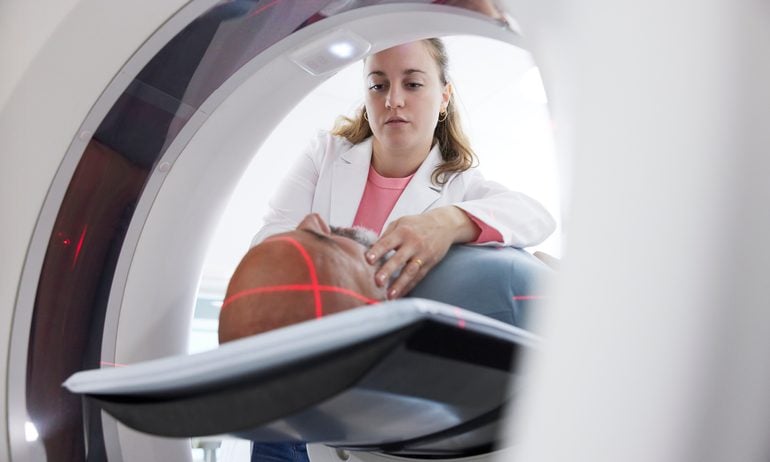How to Avoid the Cost, Risk and Stress of Unneeded Medical Tests
More than half of the billions of annual tests in the U.S. may be unnecessary. Here’s how to talk to your doctor about it.

Many, or all, of the products featured on this page are from our advertising partners who compensate us when you take certain actions on our website or click to take an action on their website. However, this does not influence our evaluations. Our opinions are our own. Here is a list of our partners and here's how we make money.
You might not be surprised to learn that U.S. health care facilities administer an enormous number of tests. One study in the American Journal of Medicine estimated 4 billion to 5 billion imaging, lab and other diagnostics annually.
But here’s the 2017 report’s shocker: Approximately half of those tests were found to be medically unnecessary.
Unneeded tests incur a price tag without clear medical benefit, and they can cause harm, including pain and injury, psychological stress and financial hardship. Patients stung by these harms sometimes decline necessary care, compromising their health.
As a patient faced with an order for a spate of tests, how can you begin to cut out the diagnostics you don’t need? Necessary medical tests save thousands of lives each year, and you could endanger yourself by refusing a diagnostic without the agreement of your doctor. So preparing for a discussion with the ordering clinician is a wise move for any health care consumer.
Clinicians order unneeded tests for various reasons
Why do physicians recommend tests that their own profession may deem unnecessary?
Defensive medicine: Some clinicians order unneeded tests for fear of malpractice liability for an undiagnosed illness. Defensive medicine is often cited as a driver of overtesting, but it’s far from the only causal factor.
The profit motive: For-profit hospitals are more prone to overtesting than their nonprofit counterparts, according to a 2021 study of Medicare claims from more than 3,300 U.S. hospitals. The study also found that nonteaching hospitals had the greatest overuse, especially in the South. As long as fee-for-service is the business model for much of U.S. health care, profits from diagnostics will drive excessive testing.
Individual clinician characteristics: A 2022 study demonstrates that individual clinicians’ cognitive and personality traits — including risk aversion, discomfort with medical uncertainty and insufficient understanding of statistics — are significant factors in overtesting. One result is inconsistent adherence to medicine’s standards of care.
“It’s a huge disservice to patients that the care you get will be very different depending on which doctor you see,” says Daniel Morgan, a co-author of the study and director of the Center for Innovation in Diagnosis at the University of Maryland School of Medicine.
Unnecessary diagnostics can trigger a cascade of tests and procedures
Especially with tests that carry big price tags or other potential harms, it’s bad enough to undergo even one that’s medically unnecessary. And some kinds of diagnostics, such as imaging, carry a relatively high risk of spawning a cascade of unnecessary care.
MRI and CT scans are among the most impactful overused tests, says Deborah Korenstein, an internist and senior medical director at Mountain Sinai Health System. “When you do imaging tests, they find things going on in your body — everybody has stuff that nobody needs to know about,” like clinically insignificant scar tissue.
“Especially if the reason for doing the test was kind of squishy, imaging can lead you down a garden path of doing one test after another,” said Korenstein. “Because once you know an abnormality is there, you have to do something about it. That’s why you want to be sure to only do tests when they are medically indicated.”
Cascades of care and testing showed that consequent harms are widespread, according to 2019 research by Ishani Ganguli and colleagues, published in the Journal of the American Medical Association. The study reported that 68.4% of physicians said cascades of care caused their patients psychological harm and 15.6% noted physical harm to patients.
What harms can unneeded tests cause?
Diagnostics are critically important to our continued well-being. But unnecessary tests can cause a variety of problems.
“Patient harms can include physical harm, psychological harm such as the stress of waiting for results, and treatment burden,” says Ganguli, who is an assistant professor at Harvard Medical School. “It’s not trivial to take a day off work for a diagnostic test; and there’s the financial burden — patients’ out-of-pocket costs.”
The physical harms of diagnostics can range from injuries caused by a biopsy to the slight increase in cancer risk from repeating certain high-dose imaging techniques. (Depending on your condition, the diagnostic benefit of a test may be well worth the risk; discuss such trade-offs with your doctor.)
As for psychological harm, “Medical events in themselves can be a cause of traumatic stress, both for children and for adults,” concludes a 2023 research paper on emergency room care, published in Medical Education Online. Patients awaiting test results may suffer significant stress — a price worth paying only if the test was necessary.
For many patients, extraneous diagnostics are also a large expense, especially if they are uninsured or have a high-deductible health plan.
“There are direct and indirect costs of getting to appointments for labs or imaging: transportation, gas, parking costs, child care,” says Meera Ragavan, an oncology fellow at the University of California San Francisco Medical Center. “Estimating upfront what your out-of-pocket costs are going to be is nearly impossible.”
How to talk to your doctor about tests
It can be daunting and feel awkward to ask a medical professional to explain why you need a particular test. But Ragavan says, “It’s the physician’s duty to talk to patients about risks and benefits of tests. It’s always in the patient’s purview to ask about side effects, risks and costs.”
Unnecessary tests are often born of a misunderstanding between a doctor and their patient, according to Korenstein. “Doctors often think a patient expects or wants tests that the patient doesn’t actually expect or want — studies show this happens a lot. Often patients don’t want tests, they want reassurance. A test may seem like a shortcut to reassurance and it isn’t, because sometimes it opens a Pandora’s box.”
So if a doctor recommends a test and you’re not sure why, you can ask, “How will the results change what we’re going to do?” said Korenstein. She gives this example: “Often with a urinary tract infection, it’s very obvious what the patient has. The doctor says, ‘I think you have a UTI, but let’s get a urinalysis and urine culture.’ Often you don’t really need that. If you ask the doctor, ‘What are you going to do if the test is negative?’ they’ll say, ‘I’m going to treat you anyway.’”
Ultimately, Korenstein says, “I don’t think it should be on patients to decide, ‘I want this test.’ Instead, patients need to tell doctors, ‘This is what I’m afraid of.’’’
Choosing Wisely — a public health campaign designed to motivate doctor-patient conversations about the value of various tests, treatments and procedures — recommends that you ask these questions:
What are the risks of the tests you’re ordering? Will there be side effects? What are the chances of getting results that aren’t accurate? Could that lead to more testing or another procedure?
What happens if I don’t do anything? Might my condition get worse — or better — if I don’t have the test or procedure right away?
How much does it cost? Are there less expensive tests?

